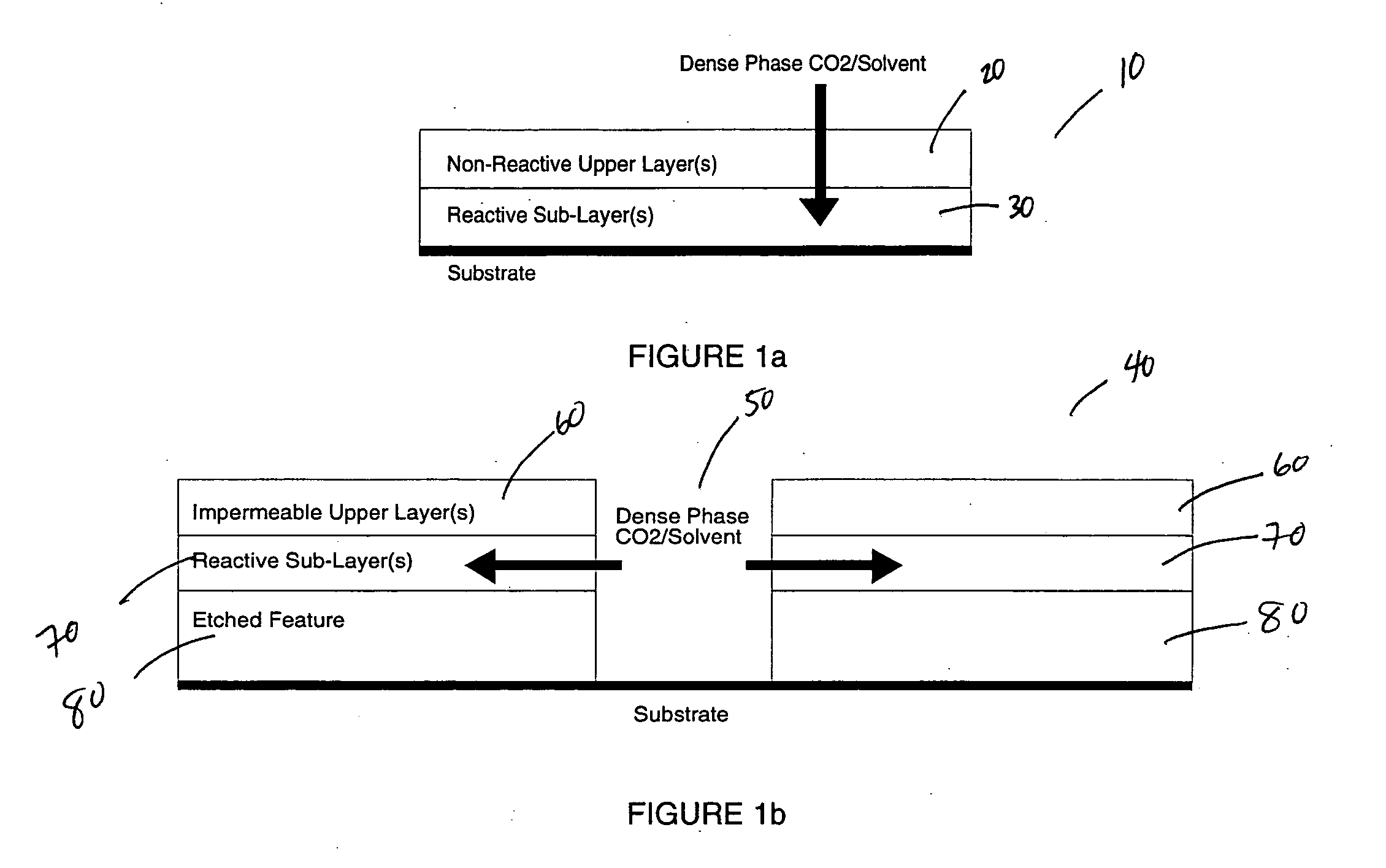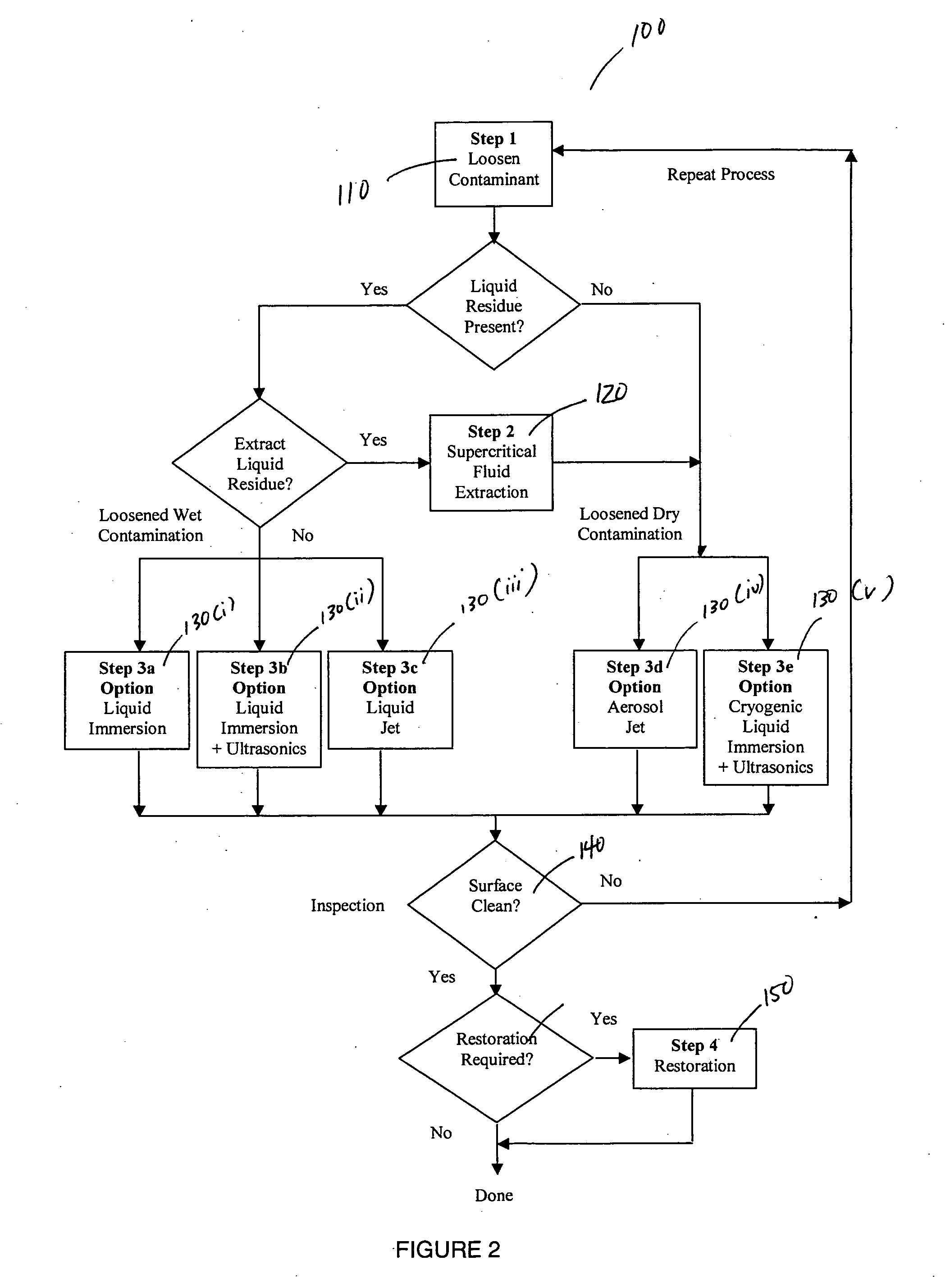Dense fluid compositions and processes using same for article treatment and residue removal
a technology of fluid composition and composition, applied in the direction of cleaning using liquids, instruments, photomechanical equipment, etc., can solve the problems of significant yield reduction, increased manufacturing costs, and detrimental microchip presence of contaminants
- Summary
- Abstract
- Description
- Claims
- Application Information
AI Technical Summary
Problems solved by technology
Method used
Image
Examples
example 1
[0073] A silicon article having a dielectric thin film was covered with a photoresist and was exposed to a lithographic and an etching process to form topographical features such as trenches. After processing, the photoresist material on the article surface contained a cross-linked polymer that was still permeable to vertical penetration by one or more dense fluids. The article was similar to the article depicted in FIG. 1a, except it had topographical features.
[0074] The article was placed in the processing chamber. In a separate vessel, a mixture was prepared that contained 76 wt. % of DMSO, 6 wt. % water and 18 wt. % of a TMAH / water solution (which consisted of 25 wt. % TMAH and 75 wt. % water). The mixture was then combined with CO2 in its dense fluid state at 30 wt. % to provide the dense processing fluid (i.e., the dense processing fluid containing 70 wt. % of the mixture and 30 wt. % of the dense fluid CO2). The article was treated with the dense processing fluid in the proc...
example 2
[0078] An article consisting of SiO2 and dielectric thin films deposited on a copper layer was covered with a multi-layered photoresist film. The multi-layered film consisted of acrylic polymer covering a glass layer, which covered a polymer sub-layer. This stratified photoresist was impermeable to vertical penetration by dense phase fluid mixtures. The article was exposed to lithographic and etching processes to form surface features. The resulting substrate topography contained regions of closely spaced vias separated by open regions containing no etched features. The article was similar to the article depicted in FIG. 1b.
[0079] The article was placed in the processing chamber. In a separate vessel, a mixture was prepared that contained 44.6 wt. % of DMAC, 30 wt. % ethanol and 25.4 wt. % of a TBAF / water solution (which consisted of 25 wt. % TBAF and 75 wt. % water). The mixture was then combined with 50 / 50 by wt. % with ethanol and the 50 / 50 ethanol-containing mixture was then co...
example 3
[0083] The article containing photoresist and post-etch residue was placed in the processing chamber. In a separate vessel, a dense processing solution was prepared that contained CO2 as the dense fluid, DMSO and methanol as the co-solvents, and a TMAH / water solution (which consisted of 25 wt. % TMAH and 75 wt. % water) as the processing agents. The total processing agent concentration was ˜0.3 wt % in the dense CO2 fluid and the DMSO and methanol concentrations were 3.5 wt % and 0.37 wt %, respectively. The article was treated with the dense processing fluid in the processing chamber at a pressure of 3600 psig, a temperature of 50° C., and for a time of 10 minutes. During the treatment step, the article was also exposed to the agitation source, or a mechanical agitator at an agitation rate of 500 rpm.
[0084] A second mixture was prepared that contained 97 wt. % of ethanol and 3 wt. % of water. To this second mixture, a certain amount of CO2 in the dense fluid state was added to pro...
PUM
 Login to View More
Login to View More Abstract
Description
Claims
Application Information
 Login to View More
Login to View More - R&D
- Intellectual Property
- Life Sciences
- Materials
- Tech Scout
- Unparalleled Data Quality
- Higher Quality Content
- 60% Fewer Hallucinations
Browse by: Latest US Patents, China's latest patents, Technical Efficacy Thesaurus, Application Domain, Technology Topic, Popular Technical Reports.
© 2025 PatSnap. All rights reserved.Legal|Privacy policy|Modern Slavery Act Transparency Statement|Sitemap|About US| Contact US: help@patsnap.com



